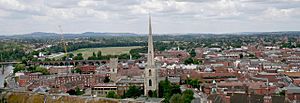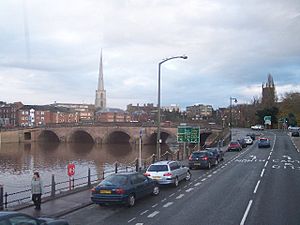Glover's Needle facts for kids



The Glover's Needle is a famous tall spire in the city of Worcester, England. It is also known as the St Andrews Spire. This landmark used to be part of a church called St Andrew's, but now it stands alone.
Contents
What is the Glover's Needle?
This tall tower is a very important landmark in Worcester. You can see it from roads, trains, and the River Severn. It can be spotted from many miles away. The very top of the spire is 74.7 meters (245 feet) high. This makes it the tallest building in Worcester.
The Glover's Needle is in St Andrews Gardens. It is close to Worcester College of Technology. The spire was once the top of the St Andrew church. However, the church itself was taken down in the late 1940s. The spire stands on Deansway. Worcester Cathedral is very close to its south side. All Saints Church is to its north.
On the west side of the spire, you can walk down into gardens. These gardens lead to the River Severn. Across the road from the Glover's Needle is a "House of Fraser" shop. This shop is built where the old St Andrew's churchyard used to be. At night, the spire lights up. A blue light shines from inside one of its windows. This blue color stands for St Andrew. It is the same color as the Scottish flag. The Rotary Club of Worcester Severn paid for these lights. They were put in place to celebrate the year 2000.
The History of the Spire
The original St Andrew's church was built in the 1400s. It had a very tall spire. But a huge storm in 1733 destroyed it. The spire was rebuilt in 1751 by Nathaniel Wilkinson. He used a clever method to lift the stones. They used kites to carry the heavy stones up!
People in Worcester loved the new spire. They called it the 'Glover's Needle'. This name came from the city's history. Worcester was famous for making gloves. So, many people worked as glove makers. The entire structure is about 245 feet tall. It is the tallest spire in England with such a narrow shape.
In the 1920s, old, crowded houses around the church were removed. This meant fewer people lived near the church. So, fewer people went to St Andrew's. The church started to fall apart. Its churchyard became overgrown. It had very few churchgoers. Its parish, or area it served, was tiny.
In the 1940s, the city council accepted an offer from the Bishop of Worcester. The Bishop offered them the church. The council decided to take down the church. They wanted to create a garden of remembrance there. But they chose to leave the tower and spire standing alone. The rest of St Andrew's church was taken down in 1949. The very top part of the spire was replaced with a copy. The original top can be found in the public garden. This garden replaced the old church.
Recent Changes and Wildlife
Around the year 2000, a clock was put into the tower. This was a special project for the new millennium. Now, the hours are chimed on the council bell. There's a tradition that has been brought back. The council bell rings from 6:45 PM to 6:50 PM. This happens before a full meeting of the council.
In the early 2000s, a fence was put around the bottom of the spire. Over a decade ago, the RSPB became involved. They now use the spire for special birds of prey. These birds use the spire as a place to rest. Live webcams have also been put inside the tower. This lets people watch the birds.
The Bells of the Spire
The Glover's Needle once had five bells. These bells were hung to allow for a special type of English bell ringing. This is called change ringing. In 1870, four of the bells were sold. But the heaviest bell, called the tenor, was kept. This bell weighs 20 CWT, which is 1 ton. This is the same "council bell" mentioned earlier. It is unlikely that the Glover's Needle could hold a full set of bells today. This is because there is no church building to help support the tower.

